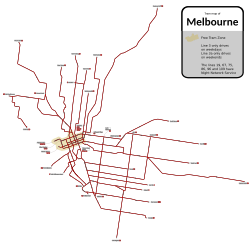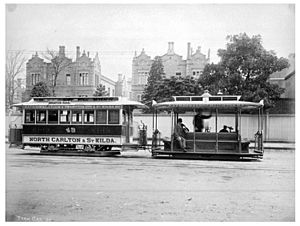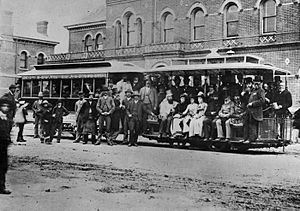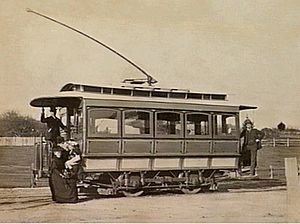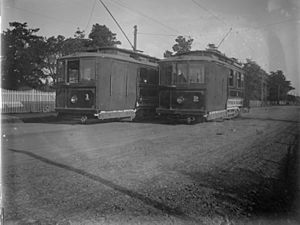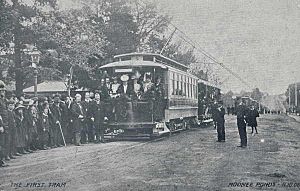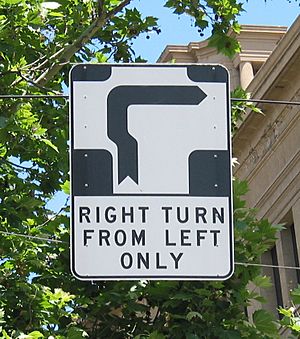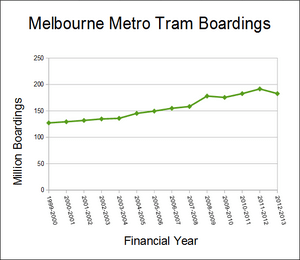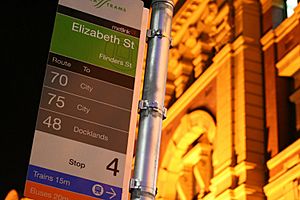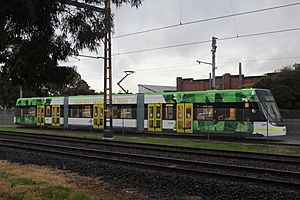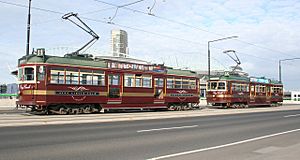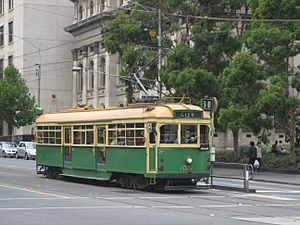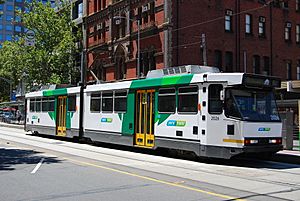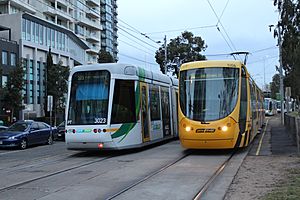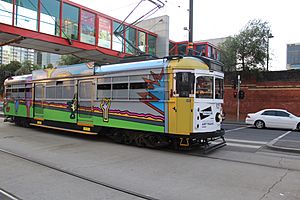Trams in Melbourne facts for kids
| Public Transport Victoria | ||||||||||||||||||||||||||||||||
 |
||||||||||||||||||||||||||||||||
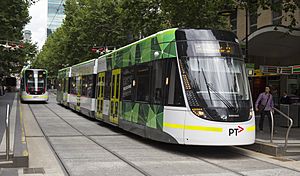
E-class trams on Bourke Street in 2013
|
||||||||||||||||||||||||||||||||
| Operation | ||||||||||||||||||||||||||||||||
|---|---|---|---|---|---|---|---|---|---|---|---|---|---|---|---|---|---|---|---|---|---|---|---|---|---|---|---|---|---|---|---|---|
| Locale | Melbourne, Victoria, Australia | |||||||||||||||||||||||||||||||
|
||||||||||||||||||||||||||||||||
|
||||||||||||||||||||||||||||||||
|
||||||||||||||||||||||||||||||||
Trams are a major form of public transport in Melbourne, the capital city of the state of Victoria, Australia. As of May 2017, the Melbourne tramway network consists of 250 kilometres (160 miles) of double track, 493 trams, 24 routes, and 1,763 tram stops. The system is the largest operational urban tram network in the world. Trams are the second most used form of public transport in overall boardings in Melbourne after the commuter railway network, with a total of 206 million passenger trips in 2017–18.
Trams have operated continuously in Melbourne since 1885 (the horse tram line in Fairfield opened in 1884, but was at best an irregular service). Since then they have become a distinctive part of Melbourne's character and feature in tourism and travel advertising. Melbourne's cable tram system opened in 1885, and expanded to one of the largest in the world, with 75 kilometres (46.6 miles) of double track. The first electric tram line opened in 1889, but closed only a few years later in 1896. In 1906 electric tram systems were opened in St Kilda and Essendon, marking the start of continuous operation of Melbourne's electric trams.
Victoria's public transport system was reorganised in 1983 and saw the Melbourne & Metropolitan Tramways Board absorbed into the Metropolitan Transit Authority, which was in turn absorbed by the Public Transport Corporation in 1989. The network has been operated under contract since the commencement of franchising, following the privatisation of the Public Transport Corporation in 1999. The current private operator contracted to run Melbourne's tram system is Keolis Downer, trading as Yarra Trams.
Ticketing, public information and patronage promotion are undertaken by Victoria's public transport body, Public Transport Victoria. The multi-modal integrated ticketing system, myki, currently operates across the tram network.
At some Melbourne intersections (most within the CBD), motor vehicles are required to perform a hook turn, a manoeuvre designed to give trams priority. To further improve tram speeds on congested Melbourne streets, trams also have priority in road usage, with specially fitted traffic lights and exclusive lanes being provided either at all times or in peak times, as well as other measures.
History
Horse trams
Melbourne's first tram was a horse tram from Fairfield railway station to a real estate development in Thornbury, it opened on 20 December 1884, and was closed by 1890. Seven horse trams operated in Melbourne, three lines were built by the Melbourne Tramway & Omnibus Company (MTOC), while the other four were built by different private companies.
The MTOC's three lines fed their cable tram system: Victoria Bridge cable tram terminus to Kew (Boroondara Cemetery), opened in 1887 and closed in 1915 after its sale to Kew Council for conversion to a Prahran & Malvern Tramways Trust electric line; Hawthorn Bridge cable tram terminus to Auburn Road, via Burwood Road, Power Street and Riversdale Road, opened in 1890 and closed on 31 January 1916 after being sold to the Hawthorn Tramways Trust for conversion to electric traction; and the Zoo line, from the Royal Parade cable line to Melbourne Zoological Gardens, opened on 10 March 1890 and closed in November 1923. The Zoo line was Melbourne's last horse tram and the only line still in operation at the formation of the Melbourne & Metropolitan Tramways Board (MMTB), it was destroyed by fire during the 1923 police strike; the MMTB took the decision not to reopen it, ending Melbourne's horse tram era.
Cable trams
Melbourne's cable tram system has its origins in the MTOC, started by Francis Boardman Clapp in 1877, with a view to operate a Melbourne tram system. After some initial resistance, he successfully lobbied the government who passed the Melbourne Tramway & Omnibus Company Act 1883 on 10 October 1883, granting the company the right to operate a cable tram system in Melbourne. Although some lines were originally intended to be horse trams, and the MTOC did operate three horse tram lines on the edges of the system, the core of the system was built as cable trams.
The Act established the Melbourne Tramways Trust (MTT), which was made up of the 12 municipalities that the MTOC system would serve. The MTT was responsible for the construction of tracks and engine house, while the MTOC built the depots, offices and arranged for the delivery or construction of the rolling stock. The MTT granted a lease to operate the system until 1 July 1916 to the MTOC, with the MTOC paying 4.5% interest on the debts incurred by the MTT in building the system.
The first cable tram line opened on 11 November 1885, running from Bourke Street to Hawthorn Bridge, along Spencer Street, Flinders Street, Wellington Parade and Bridge Road, with the last line opening on 27 October 1891. At its height the cable system was one of the largest in the world, with 75 kilometres (47 mi) of double track, 1200 grips and trailers and 17 routes covering (103.2 route km or 64.12 route miles).
On 18 February 1890, the Northcote tramway was opened by the Clifton Hill to Northcote & Preston Tramway Company. This was Melbourne's only non-MTOC cable tram, built by local land speculators and was operated as an independent line, feeding the Clifton Hill line.
When the lease expired on 1 July 1916, all the assets of the MTT and MTOC cable network were taken over by the Melbourne Tramways Board (MTB). The MMTB was formed on 1 November 1919, taking over the MTB cable tram network, with the Northcote tramway and the tramway trusts transferred to the MMTB on 20 February 1920.
From 1924 the cable tram lines were progressively converted to electric trams, or abandoned in favour of buses, with the last Melbourne cable tram operating on 26 October 1940.
First electric trams
The first electric tram in Melbourne was built in 1889 by the Box Hill and Doncaster Tramway Company Limited—an enterprise formed by a group of land developers—and ran from Box Hill railway station along what is now Station Street and Tram Road to Doncaster, using equipment left over from the Centennial International Exhibition of 1888 at the Royal Exhibition Building. The venture was marred with disputes and operational problems, and ultimately failed, with the service ceasing in 1896.
After this venture failed, electric trams returned on 5 May 1906, with the opening of the Victorian Railways Electric Street Railway Electric Street Railway from St Kilda to Brighton, and was followed on 11 October 1906 with the opening of the North Melbourne Electric Tramway & Lighting Company (NMETL) system, which opened two lines from the cable tram terminus at Flemington Bridge to Essendon and Saltwater River (now Maribyrnong River).
Victorian Railways Electric Street Railways
The Victorian Railways line came about when Sir Thomas Bent became Premier. A corrupt politician and leading land boomer, he stood to benefit from construction of the line, through the increased value of his large land holdings in the area, and pushed through the legislation to enable to building of the line by the VR in 1904.
The VR tram was called a "Street Railway" and was built using the Victorian Railways 5 ft 3 in (1,600 mm) broad gauge instead of the cable tramway standard gauge of 4 ft 8 1⁄2 in (1,435 mm), and connected it with the St Kilda railway station, to allow trams to be moved along the St Kilda railway line for servicing at Jolimont Yard. The line was opened in two stages, from St Kilda railway station to Middle Brighton on 5 May 1906 and to Brighton Beach terminus on 22 December 1906.
A fire at the Elwood tram depot on 7 March 1907 destroyed the depot and all the trams. Services resumed on 17 March 1907 using four C-class trams and three D-class trams from Sydney, which were altered to run on VR trucks salvaged from the fire. These trams sufficed until Newport Workshops built 14 new trams. The St Kilda to Brighton Beach Electric Street Railway closed on 28 February 1959 and was replaced by buses.
VR opened a second, standard gauge, electric tramway from Sandringham railway station to Black Rock on 10 March 1919, it was extended to Beaumaris on 2 September 1926. The service was withdrawn on 5 November 1956 and replaced with buses.
North Melbourne Electric Tramway & Lighting Company
The North Melbourne Electric Tramway & Lighting Company (NMELT) was an electricity and tramway company that operated from 1906 to 1922. The tramway section was taken over by the MMTB on 1 August 1922 and the electricity section taken over by the State Electricity Commission of Victoria in 1922.
The Victorian Government of Sir Thomas Bent approved an application by Mr Morgan to build a tramway system in the Essendon area on 29 March 1904, with a poll of ratepayers overwhelming supporting the proposition on 29 July 1904 (2874 votes to 146). Mr Morgan transferred the concession to the NMELT, which had been formed to build the system and provide electricity to the area. Under the concession the NMELT was to construct a tramway and provide electricity within the municipalities of Essendon and Flemington for 30 years, it also mandated a service at least every 20 minutes and had provisions for the undertaking to become property of the municipalities involved earlier than the prescribed 30 years.
The NMELT bought land on Mount Alexander Road for its offices, car barn and power house, with the foundation stone laid by the Mayors of Essendon and Flemington on 24 May 1905, and the first rail laid a month later by Premier Bent. The system opened on 11 October 1906 operating two routes from Flemington Bridge—one to Essendon via Mount Alexander Road, Pascoe Vale Road, Fletcher Street and onto Mount Alexander Road again (with a short branch line along Puckle Street), and the second to Saltwater River via Mount Alexander Road, Victoria Street, Racecourse Road, Epsom Road, Union Road and Maribyrnong Road. The system was approximately 7 mi (11.3 km) and was operated by 25 motor cars and 10 trailers.
The tramway trusts
Due to demand for better public transport in Melbourne's inner suburbs of Prahran and Malvern the Prahran & Malvern Tramways Trust Act 1907 was enacted. Councillor Alex Cameron of Malvern, who led the push for a municipal tramway service, was elected chairman of the trust by both Malvern & Prahran councils. Construction began on its first tram line in 1909 with the first passenger service commencing on 30 May 1910. Using overhead wires to feed electricity to the trams, this network continued to expand so greatly & profitably that when the MMTB was established in July 1919 Alex Cameron was appointed its full-time chairman.In 1913, the region covered by the PMTT was extended and, thus, representatives of the Hawthorn and Kew councils were also included on the board. In 1916 Camberwell council representatives were also included.
Following the PMTT, the following municipal trusts were formed:
- Hawthorn Tramways Trust – 1914 (Municipalities of Melbourne, Richmond, Hawthorn & Camberwell)
- Melbourne, Brunswick & Coburg Tramways Trust – 1916 (Municipalities of Brunswick, Coburg & Melbourne)
- Fitzroy, Northcote & Preston Tramways Trust– in process of construction when taken over in 1920 (Municipalities of Fitzroy, Northcote & Preston)
- Footscray Tramway Trust – in process of construction when taken over in 1920 (Municipality of Footscray)
Network under MMTB
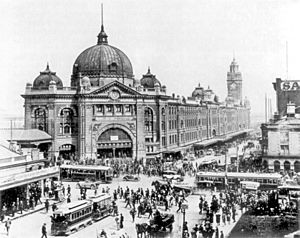
Alex Cameron, Chairman of the MMTB was in charge of a tramway network that had both cable and electric traction and had been constructed by different bodies without any uniform system. Under Cameron's guidance the Tramways Board was to bring these under a single control, extend the electric lines, and convert the existing cable-system to electric traction. To solve operational and maintenance problem the MMTB introduced in 1923 the iconic W-class tram and phased out the other models. The Preston Workshops were constructed about this time to manufacture and maintain the new tram fleet.
In March 1923 Alex Cameron went overseas to investigate traffic problems. He returned next year confirmed in his long-held opinions that electric trams were superior to buses and that overhead wires were preferable to the underground conduit (cable) system. Alex Cameron remained chairman there until 1935. He died a few years later in 1940, the same year the last of the cable tram services in Melbourne ended.
The MMTB generated further patronage by developing the enormous Wattle Park in the 1920s and 1930s, it had inherited Wattle Park from the Hawthorn Tramways Trust with the HTTs takeover by the MMTB.
After World War II other Australian cities began to replace their trams with buses. However, in Melbourne, the Bourke Street buses were replaced by trams in 1955, and new lines opened to East Preston and Brunswick East.
Melbourne's tram usage peaked at 260 million trips in 1949, before dropping sharply to 200 million the following year in 1950. However usage defied the trend and bounced back in 1951, but began a gradual decline in usage which would continue until 1970. During the same period bus use also went into decline and buses have never proved as popular with passengers as trams at any time in Melbourne's history.
By the 1970s Melbourne was the only Australian city with a major tram network. Melbourne resisted the trend to shut down the network for three major reasons: partly because the city's wide streets and geometric street pattern made trams more practicable than in many other cities; partly because of resistance from the unions; and partly because the Chairman of the MMTB, Sir Robert Risson, successfully argued that the cost of ripping up the concrete-embedded tram tracks would be prohibitive. Also, the infrastructure and vehicles were relatively new, having replaced Cable Tram equipment in only the 1920s–1940s. This destroyed the argument used by many other cities, which was that renewal of the tram system would cost more than replacing it with buses.
By the mid-1970s, as other cities became increasingly choked in traffic and air pollution, Melbourne was convinced that its decision to retain its trams was the correct one, even though patronage had been declining since the 1950s in the face of increasing use of cars and the shift to the outer suburbs, beyond the tram network's limits.
The first tram line extension in over twenty years took place in 1978, along Burwood Highway. The W-class trams were gradually replaced by the new Z-class trams in the 1970s, and by the A-class trams and the larger, articulated B-class trams in the 1980s.
In 1980, the controversial Lonie Report recommended the closure of seven tram lines. Public protests and union action resulted these closures not being carried out.
Metropolitan Transit Authority and Public Transport Corporation
The MMTB, along with the metropolitan railway assets of VicRail, were absorbed into the newly formed Metropolitan Transit Authority (MTA) on 1 July 1983, while the regional assets of VicRail were absorbed by the State Transit Authority (STA). The MTA was formed to co-ordinate and operate the Melbourne public transport system, during 1986–87 an integration of rail, tram and bus divisions took place, with the operations, maintenance and administration of these departments fully integrated by 11 April 1988.
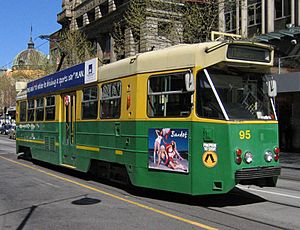
The MTA introduced a new green and yellow livery and uniform design, with a new logo, showing the integration of Melbourne's public transport system, replacing the MMTB logo, and introduced a new time-based integrated ticketing system, for all modes of Melbourne's public transport.
An Automatic Vehicle Monitoring system was introduced in 1985, improving communication with drivers and allowing tracking of trams throughout the network. This reduced tram bunching and improved reliability of tram services.
The St Kilda and Port Melbourne railway lines were converted to light rail lines in 1987, with the lines closed on 1 July 1987 and 11 October 1987 respectively. Trams first ran on the St Kilda line on 20 November 1987, with Port Melbourne following on 13 December 1987. The conversion consisted of the track being re-gauged from broad gauge 5 ft 3 in (1,600 mm) to standard gauge 4 ft 8 1⁄2 in (1,435 mm), the overhead being converted to tramway voltage and light rail platforms built adjacent to the former stations platforms.
As a result of the Transport (Amendment) Act 1989 the MTA and STA were merged into the Public Transport Corporation (PTC) on 1 July 1989, bringing all rail services in Victoria under one body.
By the late 1980s, the state government was under financial pressures brought on by an economic downturn. In January 1990, the Labor government of Premier John Cain tried to introduce economies into the running of the public transport system, including the removal of tram conductors. This provoked a long and crippling strike by the tramways union in January 1990, resulting in a back-down by the government and the retention of conductors.
In the 1992 state election, the Liberals came to power under Premier Jeff Kennett, who planned to cut the costs of Melbourne's public transport network and remove conductors. OneLink were contracted in 1995 to introduce an automatic ticketing system. The tramway union, which opposed this move, went on strike during the 1997 Grand Prix. One month later the government announced plans for privatisation of the PTC. The tram conductors were replaced with ticketing machines between 1996 and 1998—shortly before the system was privatised. This move led to the loss of millions of dollars in revenue through fare evasion.
Privatisation

On 1 July 1997, in preparation for privatisation of the Public Transport Corporation, Melbourne's tram network was split into two businesses: Met Tram 1 (later renamed Swanston Trams) and Met Tram 2 (later renamed Yarra Trams). VicTrack, a new statutory authority within the Victorian Government, was created in 1997 to hold the ownership of land and assets relating to Victoria's tram and rail systems. In addition, a statutory office was established—the Director of Public Transport—to procure rail and tram services and to enter into and manage contracts with transport operators.
After a tendering process the businesses were awarded as 12-year franchises, with Swanston Trams won by National Express, and the Yarra Trams business by TransdevTSL. Following a transitional period, the right to operate the two tram businesses was officially transferred from the government to the private sector under franchise agreements on 29 August 1999.
National Express renamed Swanston Trams as M>Tram, similarly along with its M>Train suburban train business, on 1 October 2001. After several years of failing to make a profit, more than a year of negotiations over revised financing arrangements with the government, and grave concern over its future viability, National Express Group announced on 16 December 2002, its decision to walk away from all of their Victorian contracts and hand control back to the state government, with funding for its operations to stop on 23 December 2002. The government ran M>Tram until negotiations were completed with Yarra Trams for it to take-over responsibility of the whole tram network from 18 April 2004.
On 25 June 2009, it was announced that Keolis Downer, a joint venture between Keolis and Downer EDI, would be the operator of the Melbourne tram network from 30 November 2009. The contract is for eight years with an option for a further seven years.
Recent
As a part of the privatisation process, franchise contracts between the state government and both private operators included obligations to extend and modernise the Melbourne tram network. This included acquiring new tram rolling stock, in addition the existing tram fleet was refurbished. Swanston Trams (M>Tram) introduced 59 new Combino (D-class) low-floor built trams by Siemens, at a cost of A$175 million, and invested approximately A$8 million in refurbishing their fleet, while Yarra Trams introduced 36 Citadis (C-class) low-floor trams from Alstom, at a cost of A$100 million, and invested A$5.3 million refurbishing their fleet.
In 2003 the marketing and umbrella brand Metlink was introduced to co-ordinate the promotion of Melbourne's public transport and the communications from the separate privatised companies. Metlink's role was to provide timetables, passenger information about connecting services provided by several operators, fares and ticketing information and introduce uniform signage across the Melbourne public transport system.
Since privatisation extensions have been made to the tram system, with the $28 million extension of the 109 to Box Hill opening on 2 May 2003, a $7.5 million extension along Docklands Drive in Docklands opened on 4 January 2005, and a $42.6 million extension of the 75 to Vermont South opening on 23 July 2005.
It was announced on 27 September 2010 that Bombardier Transportation had won a $303 million contract to supply and maintain 50 new E-class trams, the contract includes an option for a further 100. They will be built at Bombardier's Dandenong factory, with the propulsion systems and bogies coming from Bombardier's factories in Mannheim and Siegen, Germany, respectively. The trams will be 33 metres long and have a capacity of 210 passengers and are due to be in service in 2013. The first E-class tram arrived at Preston Workshops in late June 2013 for testing, with the first two E-class entering revenue service in November 2013.
In April 2012, Public Transport Victoria (PTV), a new statutory authority was formed after amendments to the Transport Integration Act 2010 and the passing of the Transport Legislation Amendment (Public Transport Development Authority) Act 2011. PTV assumed responsibility from the Director of Public Transport for the provision and administration of Victoria's transport services. It also provides information on fares, transport services and initiatives, and is responsible for overseeing and improving Victoria's public transport services.
The era since privatisation has also brought large patronage increases, an increase in platform stops, and a new ticketing system. In 1999–2000 year—when the tram system was privatised—patronage was 127.3 million per annum, this has increased almost each year since, and in the 2012–2013 year was 182.7 million passenger trips, a 4.2% year-on-year patronage increase; trams are the second most utilised public transport method, between trains and buses. Yarra Trams, the Department of Transport, and later Public Transport Victoria, are introducing level boarding stops to improve accessibility and safety, and comply with the Disability Discrimination Act; as of January 2014 360 accessible stops have been constructed, all since 1999. The Metcard ticketing system which operated from 1996 was switched off on 29 December 2012, leaving myki—which has been in operation on Melbourne trains since 29 December 2009, and valid on Melbourne trams and buses since 25 July 2010—as the sole ticketing system.
Fleet
The Melbourne tram fleet currently comprises 501 trams as of November 2014. Classification is based on the original system begun by the MMTB in 1921.
All the rolling stock is leased to Yarra Trams, with the W-, Z-, A- and B-class trams owned by the Victorian Government, and the C-class and D-classes are subject to lease purchase agreements, while the C2-class trams were leased from Mulhouse, France but are now state assets.
W-class trams
- 752 trams built in total 1923–1956, in service 1923–present
- ~230 total currently, ~165 in storage, 27 stored operational in "ready reserve", 26 in revenue service, 12 operated on the City Circle.
W-class trams were introduced to Melbourne in 1923 as a new standard design. They had a dual-bogie layout with a distinctive "drop centre" section, allowing the centrally placed doors to be closer to the ground. They are a simple rugged design, with a substantially timber frame, supplanted by a steel under-frame, characterised by fine craftsmanship. The W-class was the mainstay of Melbourne's tramways system for 60 years. A total of 752 trams of 12 variants were built, the last in 1956.
It was not until the 1980s that the W-class started to be replaced in large numbers, and by 1990 their status as an icon for the city was recognised, leading to a listing by the National Trust. Public outrage over their sale for tourist use overseas led to an embargo on further export out of the country in 1993, though recently some have been given or loaned to various Museums. Approximately 200 of the W-class trams retired since then remain stored, and the future use of these trams is unknown.
W-class trams have been sent overseas, five went to Seattle between 1978 and 1993, where they operated on Seattle's George Benson Waterfront Streetcar Line, starting in 1982 but suspended in 2005. Another nine are now part of the downtown Memphis tourist service, while several other US cities have one or two.
As of January 2015, there are about 230 W-class trams: about 165 are in storage, 27 are stored operational in "ready reserve", 12 run on the City Circle (the oldest W-class tram in service runs on the City Circle) and 26 are used in revenue service. In January 2010, it was announced by the new transport minister that the 26 W-class trams running the two inner city routes, would be phased out by 2012, prompting a new campaign from the National Trust of Australia. In 2010 it was proposed to better utilise the unused W-class trams by refurbishing and leasing them as "roving ambassadors" to other cities, generating revenue which could then be invested back into the public transport system. In 2011 the Victoria government committed $8 million over four years for the restoration of W-class trams, with options for new routes currently being considered.
Z-class trams
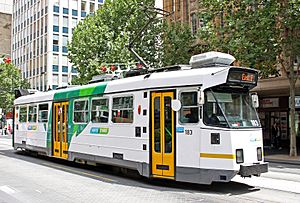
- Z1 – 100 built, made in Australia, last retired April 2016
- Z2 – 15 built, made in Australia, last retired April 2016
- Z3 – 115 built, made in Australia, 113 currently in service
The development of new rolling stock to replace the W-class finally began in the early 1970s with a modern design, based on the Gothenburg, Sweden M28 design.
The Z-class trams, built by Comeng, were introduced from 1975, starting with the Z1-class. Built from 1975 to 1979 100 trams were built, they had conductors consols that passengers would have to queue for, and only two doors, these two features hampered loading, and proved unpopular. Most of Z1-class were withdrawn following the introduction of the C, D and E class trams, with the last Z1-class withdrawn on 23 April 2016. This number in service as of March 2015 in 26. Those withdrawn were usually sold at auction, with some being donated to tram museums.
In 1978 and 1979, fifteen Z2-class trams, having little difference from the Z1-class were built. As with the Z1-class, the Z2-class trams have been withdrawn from service.
From 1979 to 1984, Z3-class trams were introduced, being a significant improvement on the Z1- and Z2-class trams. They had an additional door each side, no conductor's console was provided, and they had much smoother acceleration and braking. 115 were built, 114 of which are in service (Z3 149 was destroyed in a fire). All have either the current Yarra Trams livery or vinyl advertising wrap.
-
A Z1-class tram at Federation Square, Swanston Street
-
A Z2-class tram at City Square, Swanston Street
A-class trams
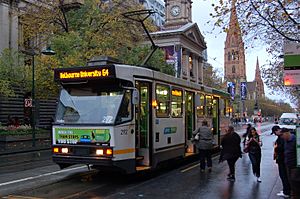
- A1 – 28 built, made in Australia, 27 still in service
- A2 – 42 built, made in Australia, all still in service
The A-class trams were built between 1984 and 1986 by Comeng. They were built as two runs, the A1-class being introduced into service between 1984 and 1985, and A2-class between 1985 and 1986. They were very similar, the major difference being the brakes, and that the A1-class were built with trolley poles, while A2-class were built with pantographs. All 70 that were built are still in service today. Though A1.231 is currently stored due to fire damage.
-
An A1-class tram at Federation Square, Flinders Street
B-class trams
- B1 – 2 built, made in Australia, withdrawn 2016
- B2 – 130 built, made in Australia, 129 in service, air conditioned
The B-class trams (also known as light rail vehicles) were first introduced to Melbourne in 1984 with the first prototype B1-class trams, the second being built in 1985, both remain in service today. The B-class trams used the same traction equipment as the Z3 and A-class trams, and were built for the light rail lines. They were originally built with movable steps to allow railway platform and street level boarding, but this concept was later abandoned, with low floor platform built at the converted light rail stations.
B2-class trams entered service from 1988–1994, by Comeng, and later ABB Transportation, with 130 built, all but one of which remain in service today. The B2-class was the first Melbourne tram fitted with air-conditioning.
All of the B-class trams, are either in Yarra Trams livery or covered with all over advertising.
C-class trams (Citadis)
- C1 – 36 in service, made in France
- C2 – 5 in service, made in France (purchased from Mulhouse, France) Bumblebees
Following the privatisation of Melbourne's tram system the private operators acquired new trams to replace the older Z-class trams. In 2001 Yarra Trams introduced the Citadis or C-class trams, manufactured in France by Alstom. They are three section articulated vehicles, with 36 in service.
Five low floor C2-class trams were introduced in 2008 after being leased from Mulhouse in France. They have been dubbed 'Bumble Bees' due to their distinctive yellow colour, and exclusively run on route 96. It was announced in November 2010 that the State Government was in negotiations to purchase the 5 C2-trams, with the purchase finalised by 2013.
The C-class trams are owned by Allco entity and are subject to a lease purchase agreement. While the C2-class trams were leased from Société Générale entity, but were subsequently purchased by the Victorian Government in the 2012–2013 year.
D-class trams (Combino)
- D1 – 38 in service, made in Germany
- D2 – 21 in service, made in Germany
Following the privatisation of Melbourne's tram system the private operators acquired new trams to replace the older Z-class trams. The German made Siemens Combino trams were introduced by the now defunct M>Tram. M>Tram operations were transferred to Yarra Trams in 2004 following negotiations with the State Government after National Express walked away from its contract to operate M>Tram in 2002.
The Combino is a three-section (D1-class) or five-section (D2-class) articulated vehicle. Currently 38 D1-class and 21 D2-class trams are in service.
The D1-class and D2-class trams are owned by CBA entity and are subject to a lease purchase agreement.
According to Time Out (magazine) Melbourne, the D-Class trams are Melbourne's most hated, due to a lack of seats and other concerns.
-
A D1-class tram on Swanston Street
E-class trams (Flexity)
- E – 47 in service (With 1 in testing and commissioning) (3 June 2016, expected 1 per month delivered until order completion) out of an order of 70, made in Australia
The E-class are three-section, four-bogie articulated trams built by Bombardier Transportation's Dandenong factory, with the propulsion systems and bogies coming from Bombardier's Mannheim and Siegen factories in Germany. Bombardier were selected on 27 September 2010 following a tendering process for 50 new low floor trams, which was opened in 2009, the $303 million contract is for supply of 50 trams with maintenance to 2017, and includes an option for a further 100 trams. The trams are based upon the Flexity Swift design, and are being built at Bombardier's Dandenong factory, they are the first locally built Melbourne trams since the B-class in 1994.
They are 33 metres long, 2.65 metres wide, low floor with anti slip flooring, air-conditioned, have automatic audio visual announcements and a passenger capacity of 210. A two-thirds mock up, produced for design input was unveiled on 24 August 2011 and was displayed at the 2011 Royal Melbourne Show. Although originally anticipated to be deliver in 2012, design complexity slowed down construction, delaying delivery of the first tram. The first E-class tram arrived at Yarra Trams' Preston Workshops on 28 June, by September 2013 there were two E-class trams at Preston Workshops undergoing non-passenger testing in preparation for introduction to service in late 2013. The first two trams entered service on 4 November 2013, and were joined by a further three by the start of 2014.
According to Time Out (magazine) Melbourne, the E-Class are the city's tram passengers' favourite due to their size, design and comfort.
Depots
Melbourne's trams run out of eight depots.
| Depot | Location | Routes | Trams | |
|---|---|---|---|---|
 |
Brunswick | 807 Sydney Road, Brunswick |
1 8 Shared with Malvern 19 |
18 Z3-Class 17 B2-Class 15 D2-Class |
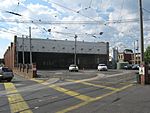 |
Camberwell | 8 Council Street, Hawthorn East |
70 75 |
19 A2-Class 23 B2-Class 1 SW6-Class |
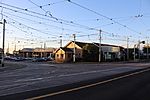 |
East Preston | 211 Plenty Road, East Preston |
86 11 |
3 A1-Class 2 B1-Class 51 B2-Class 1 SW6-Class 15 E-class 1 W6-Class |
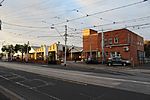 |
Essendon | 318 Mount Alexander Road, Travancore |
55 57 59 82 |
38 Z3-Class 33 B2-Class |
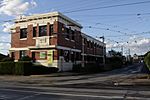 |
Glenhuntly | 893–901 Glen Huntly Road, Caulfield South |
3 64 67 78 |
3 SW6-Class 1 W7-Class 9 Z1-Class 30 Z3-Class 10 A1-Class 6 B2-Class |
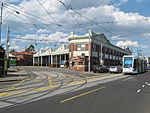 |
Kew | 61 Barkers Road, Kew |
48 109 |
12 A2-Class 36 C-Class |
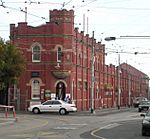 |
Malvern | 21 Coldblo Road, Armadale |
5 6 8 Shared with Brunswick 16 72 |
1 SW5-Class3 SW6-Class 1 W6-Class 17 Z1-Class 2 Z2-Class 27 Z3-Class 38 D1-Class |
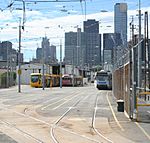 |
Southbank | 167 Normanby Road, Southbank |
30 96 12 City Circle (35) |
9 SW6-Class 3W6-Class 1 W7-Class 2 W8-Class 14 A1-Class 11 A2-Class 5 C2-Class 6 D2-Class 22 E-Class |
| Source: Vicsig | ||||
Power supply
Melbourne's tram system operates on 600 volt DC electricity, provided to the over head lines by a network of 50 substations spread across the network. Electricity is supplied to these substations in either 6,600, 11,000, or 22,000 volt AC and is then stepped down, and rectified to 600 volt DC. The overhead system is further separated into 100 sections, this is done for two reasons, one is to maintain voltage and current across the network, and two is to isolate disruptions when issues relating to the electrical transmission system occur. The most common disturbances to the supply system are over height vehicles, falling tree limbs, damaged poles, and fires nearby to overhead wires.
Since 2013 Yarra Trams have been provisioning for the upgrade of substations across the network. This is due to the increased amount of current required by newer trams such as the E-class and other low-floor trams scheduled for wider deployment across the system. Additionally, they are concurrently planning for the further segmentation of the supply network; further isolating disruptions caused by disturbance to the supply system.
In January 2017, the state government announced tenders to power Melbourne's tram network with solar power, to be supplied at Mildura with a new 75 MW solar power plant by the end of 2018
In popular culture

Melbourne's trams—especially the W-class—are an icon of Melbourne and an important part of its history and character. Trams have been featured across several media, and in tourism advertising since World War II.
Trams are a heavily featured in the movie Malcolm, one scene of the controversial film Alvin Purple, and feature in the video clips for the Beastie Boys' The Rat Cage and AC/DC's It's a Long Way to the Top. Among songs written about Melbourne's trams are Toorak Tram by Bernard Bolan, and Taking the tram to Carnegie by Oscar.
The Eastern Suburbs Professional Community Theatre Company, known as Theatre Works staged a performance on a 109 tram entitled Storming Mont Albert by Tram, between 26 February and 14 March 1982 as part of the Melbourne Moomba Festival. It was written by Paul Davies and directed by Mark Shirrefs and was revived in 1992 and 1998.
For the Melbourne 2006 Commonwealth Games a Z-class tram was decorated as a Karachi bus by a team of Pakistani decorators. Dubbed the Karachi tram, it operated on the City Circle tourist route during the Commonwealth Games. The centrepiece of the Opening Ceremony was a flying W-class tram, specially built for the event, from original W-class plans and photos.
On 26 October 2011, a Z3-class tram, specially liveried as a Royal Tram was used to convey Elizabeth II and Prince Philip, Duke of Edinburgh, from Federation Square to Government House, along St Kilda Road during their visit to Melbourne. The Royal Tram was in regular service for a little over one year following the event.
From 1978 to 1993 36 W-class trams were painted with artwork as part of the Transporting Art project. The idea was conceived in early 1978 by Melbourne Lord Mayor Irvin Rockman and artist Clifton Pugh, the idea was backed by then Premier Rupert Hamer, and over the time of the project many notable artist participated. The idea was reprised as part of the Melbourne Festival in 2013, with a competition launched in May 2013 to select eight designs, one to operate out of each Melbourne tram depot. The first of the new Melbourne Art Trams, W-class 925, was launched on 30 September 2013 by then Premier Denis Napthine and Yarra Trams CEO Clément Michel, with the remaining seven trams to be introduced in the following two weeks; the last was introduced to service on 11 October 2013.
Images for kids
-
A tram car passes the Federal Coffee Palace at the south-west corner of Collins and King streets, circa 1890.
-
Tram stop sign outside Flinders Street station.
-
A Z1-class tram at Federation Square, Swanston Street


